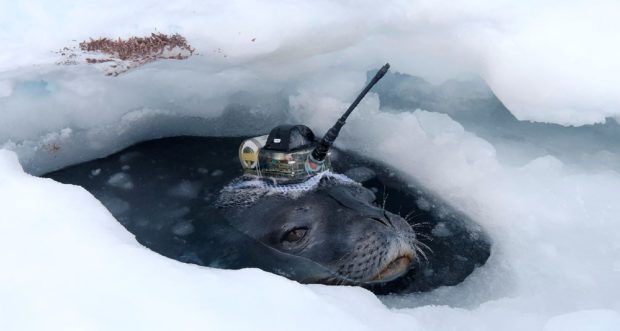Seals help Japanese researchers collect data under Antarctic ice

This video grab shows a Weddell seal fitted with high-tech head-mounted measuring devices to survey waters under the thick ice sheet, near Japan’s Showa Station in Antarctica, April 2017. National Institute of Polar Research/Handout via REUTERS
TOKYO — A seal wearing a helmet with an antenna might look unusual, but eight Weddell seals, each with a 580g monitoring device on their heads, have been helping Japanese researchers survey the waters under the thick ice sheet in Antarctica.
Tapped for a research project between March and November 2017 – winter in Antarctica – these seals were equipped with the head-mounted conductivity, temperature and depth sensor, which allows scientists to collect observation data, such as water temperatures and salt levels, in areas with extremely harsh environmental conditions.
Project leader Nobuo Kokubun said such research helps scientists trace the animals’ behavioural patterns and ecology.
“During the summer, we can go to Antarctica on icebreakers to conduct actual research activities, so that we can collect data there. But during the winter, such things cannot be done in so many places,” Kokubun said during an interview with Reuters on Friday.
“However, even in such a situation, many animals such as seals are living in the area of Antarctica, so I thought we should have them collect the data,” Kokubun added.
Article continues after this advertisementThe data successfully gathered from seven seals showed one of them had travelled as far as 633km (393 miles) from the coast of Japan’s Showa Station in Antarctica, while another had descended to a depth of 700m (2,297 ft).
Article continues after this advertisementKokubun said the scientists also learned from the data that warm seawater from the upper layer in the open sea reached Antarctica from March through winter that year. The water flowed below the ice, bringing in sea creatures like Antarctic krill, a major food source for seals.
Aiming to examine further the impact of global warming on Antarctic coastal areas, Kokubun next hopes to make the device small enough to fit on other animals at the South Pole such as penguins.
“The advantage with penguins is that they come back to the same place and we can collect the data from them immediately. Also, we can use the devices on a large number of penguins so they can cover a wide area,” he said.
RELATED STORIES
WATCH: Firefighters rescue baby seal found in parking garage
On an Alaskan island, a mayor fights for fur seals — and a new future
Seal dies in Chinese aquarium after head gets stuck in drain